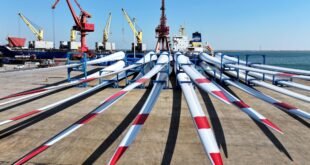The Uncertain Future of Chinese Exports in the Wake of U.S. Tariff Policies
The global trade landscape has become increasingly unpredictable, with Chinese exporters caught in a web of shifting policies and rising uncertainties. Industry insiders have described every investment as a gamble, especially for those operating factories in Southeast Asian countries that are now facing potential tariffs from the United States.
Chinese exporters like Huang Yongxing are struggling to navigate this complex environment. They are seeking clarity on whether to continue production in China or shift operations to Southeast Asia, where many have already invested. These decisions are complicated by the volatile nature of U.S. trade policies, which have created a sense of instability among manufacturers.
Huang shares his insights and updates through social media, providing valuable information to small and medium-sized business owners who are also grappling with the impact of these policies. His weekly posts have gained traction as businesses seek guidance amid the uncertainty.
The recent announcement of potential tariffs by the U.S. government has placed Southeast Asia—China’s largest export market—in a precarious position. This region is now under Washington’s trade scrutiny, directly affecting Chinese exporters’ transshipment strategies. The ambiguity surrounding these tariffs adds to the challenges faced by companies that have already expanded overseas or are planning to do so.
Many Chinese companies are forced to adopt a cautious approach, given the high stakes involved. Huang, a lighting product exporter based in Zhejiang province, has had to repeatedly revise plans to establish a factory in Cambodia due to the changing trade stance. He highlights the financial burden of maintaining both a Chinese factory and a new one in Southeast Asia, noting that it would double expenses while only generating one income.
Six out of the ten ASEAN member states are affected by the proposed tariffs, with Cambodia, Thailand, Indonesia, Laos, and Myanmar facing rates ranging from 25 to 40 percent. The highest tariffs, at 40 percent, will be imposed on Laos and Myanmar, making re-exporting to the U.S. through these countries nearly unfeasible.
According to Morgan Stanley, the current weighted average tariff on Chinese imports is estimated at 42 percent, while UBS puts it at 43.5 percent. These figures underscore the significant financial pressure on Chinese exporters.
Industry experts warn that the trend of “going global” continues, but the rising uncertainty around tariffs is shrinking strategic flexibility. Liu Kaiming, a supply-chain expert, emphasizes that without stable expectations, every investment feels like a gamble. He notes that Cambodia has a relatively complete industrial chain in the garment industry, while Laos and Myanmar have scattered factories. Once included on the high-tariff list, re-exports from these countries would be hardly feasible, leading to potential losses for Chinese factories investing there.
Despite these challenges, some domestic manufacturers see an unexpected opportunity. Wang Shui, a pet products exporter in Guangdong, believes that if Southeast Asia faces tariffs, his company might gain a relative advantage. He argues that quality products will still attract orders, as many items produced in Southeast Asia cannot be replicated.
However, Wang acknowledges that the broader trade environment is becoming more precarious. Whether staying in China or expanding abroad, manufacturers face unprecedented uncertainty. With U.S. policy shifting daily, no one can predict what lies ahead.
For hardware exporter Kevin Huang in Guangdong, the constant changes in U.S. tariff policy are intensifying short-term risks. He notes that some peers have just finished setting up their factories but are already facing cash-flow collapse. The situation is dire, with Huang hesitant to continue shipping and focusing instead on preparing for potential bad debt.
As the trade landscape continues to evolve, Chinese exporters must adapt to an environment marked by uncertainty and volatility. The path forward remains unclear, with each decision carrying significant risks and potential rewards.
 Info Malang Raya Its All About World News
Info Malang Raya Its All About World News




